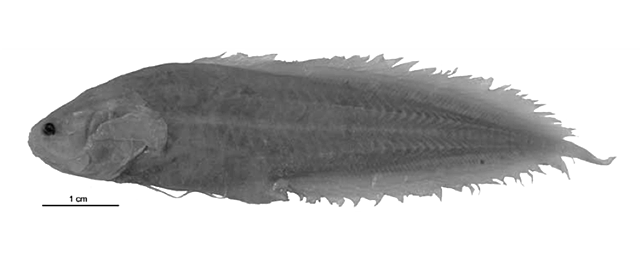| Dinematichthyidae (Viviparous brotula) |
| 8.3 cm SL (male/unsexed) |
|
pelagic-neritic; marine; depth range 0 - 16 m |
| Western Central Pacific: New Guinea-Solomon Island chain; off western Fiji. |
|
Dorsal soft rays (total): 83-86; Anal soft rays: 66-71; Vertebrae: 42-44. The species is characterized by the following: vertebrae 11+31-33=42-44, dorsal fin rays 83-86, anal fin rays 66-71; eyes very large (?3.0% SL), D/V 5-6; the outer pseudoclasper is large, more than 2 times the length of inner pseudoclasper, wing-shaped, with broad base and slightly concave pointed tip without a fleshy bulge; inner pseudoclasper joined to outer pseudoclasper anteriorly, thin, with single pointed tip, short, not extending over anterior part of outer pseudoclasper; moderately broad scale patch on cheek with 5-6 scale rows on upper cheek, small scale patch on operculum above opercular spine (4-5 scales in 2 rows); head massive; otolith moderately slender, length to height 1.9-2.0 (Ref. 57884).
Description: Characterized by depth of body at anal fin origin 18.3-21.8 (mean = 19.7) % SL; short and curved penis (Ref. 90102). |
| Solitary inhabitant of coral reef crevices, cryptic (Ref 90102). |
|
Least Concern (LC); Date assessed: 16 August 2019 Ref. (130435)
|
| harmless |
|
Type locality, Amot I., Hermit Is., Bismarck Archipelago, Bismark Sea, Manus Prov., USNM 372957 (holotype of Diancistrus eremitus, 7.1 cm SL, male) (Ref. 57884). Also in Stewart Island (Ref. 90102). |
Source and more info: www.fishbase.org. For personal, classroom, and other internal use only. Not for publication.

